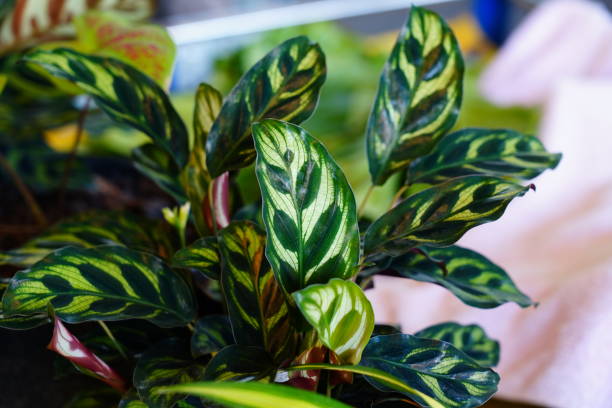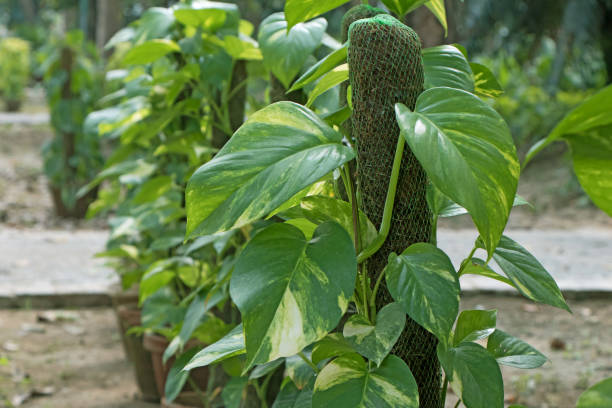The Graceful Prayer Plant: A Guide to Care and Appreciation
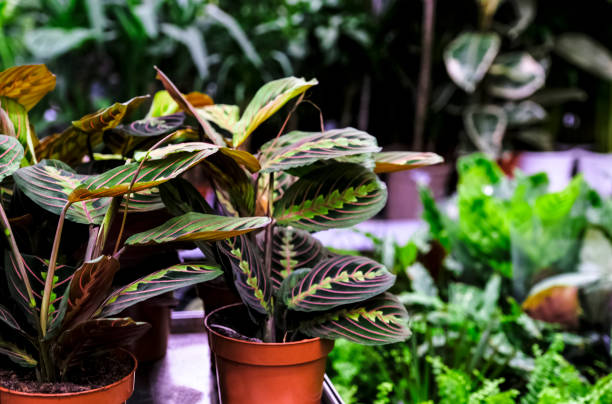
The Prayer Plant, scientifically known as Maranta leuconeura, is a special houseplant that has become popular due to its rich foliage and relatively easy care requirements. Arising from the rainforests of Brazil, the Prayer Plant is well-known for its distinctive leaves that fold up like hands in prayer during the evening, adding a unique touch of movement to any indoor space. The Prayer Plant is a perfect addition to any home or office with its stunning green and red patterned leaves. However, to keep this tropical plant thriving, it is important to understand its care requirements, including lighting, watering, and fertilizing needs. This article will explore the essential aspects of caring for a Prayer Plant, including tips for growing and maintaining a healthy and vibrant plant.
Prayer Plant Care
To keep a Prayer Plant thriving, providing it with the appropriate care is important. The following tips will help you grow and maintain a healthy and vibrant Prayer Plant:
Lighting Requirements
Prayer Plants thrive in bright, indirect light. They prefer a spot near a window but avoid placing them in direct sunlight as this can burn the leaves. If you notice the leaves fading or losing their vibrant colour, move the plant to a brighter location.
Watering Requirements
Prayer Plants require regular watering to keep the soil moist but not waterlogged. It is important to ensure that the top inch of soil is dry before watering, as overwatering can cause root rot. The watering frequency will depend on your home’s temperature, humidity, and light levels. During winter, reduce watering to allow the plant to enter a dormant period.
Humidity Requirements
Prayer Plants thrive in humid environments, making them an excellent choice for a bathroom or kitchen. However, if you do not have a humid space, you can increase humidity by misting the leaves regularly or placing a tray of water near the plant.
Fertilizing Requirements
Prayer Plants benefit from regular fertilizing during the growing season, from spring through fall. Use a balanced liquid fertilizer every four weeks to promote healthy growth.
Soil Requirements
Prayer Plants prefer well-draining, nutrient-rich soil. A mixture of potting soil and perlite or sand will provide good drainage and nutrient retention.
Propagation
Prayer Plants can be propagated by division or stem cuttings. To propagate by division, carefully remove the plant from its pot and separate the root ball into sections, ensuring each section has at least one healthy stem and root system. To propagate by stem cuttings, cut from a healthy plant, remove the lower leaves, and place the cutting in water or soil.
Pruning
Regular pruning can help keep your Prayer Plant healthy and vibrant. Remove any yellowing or dead leaves, and trim back overgrown stems to promote new growth.
Types of Prayer Plants
The Prayer Plant, or Maranta leuconeura, is a genus of plants that includes a variety of species and cultivars. Each type of Prayer Plant has its unique characteristics, including leaf colour, pattern, and size. Below are some of the most popular types of Prayer Plants:
Maranta leuconeura “Fascinator”

This cultivar features stunning dark green leaves with bright pink veins that create a mesmerizing pattern. The leaves are larger than most Prayer Plants, and the plant can grow up to 2 feet tall.
Maranta leuconeura “Kerchoveana”
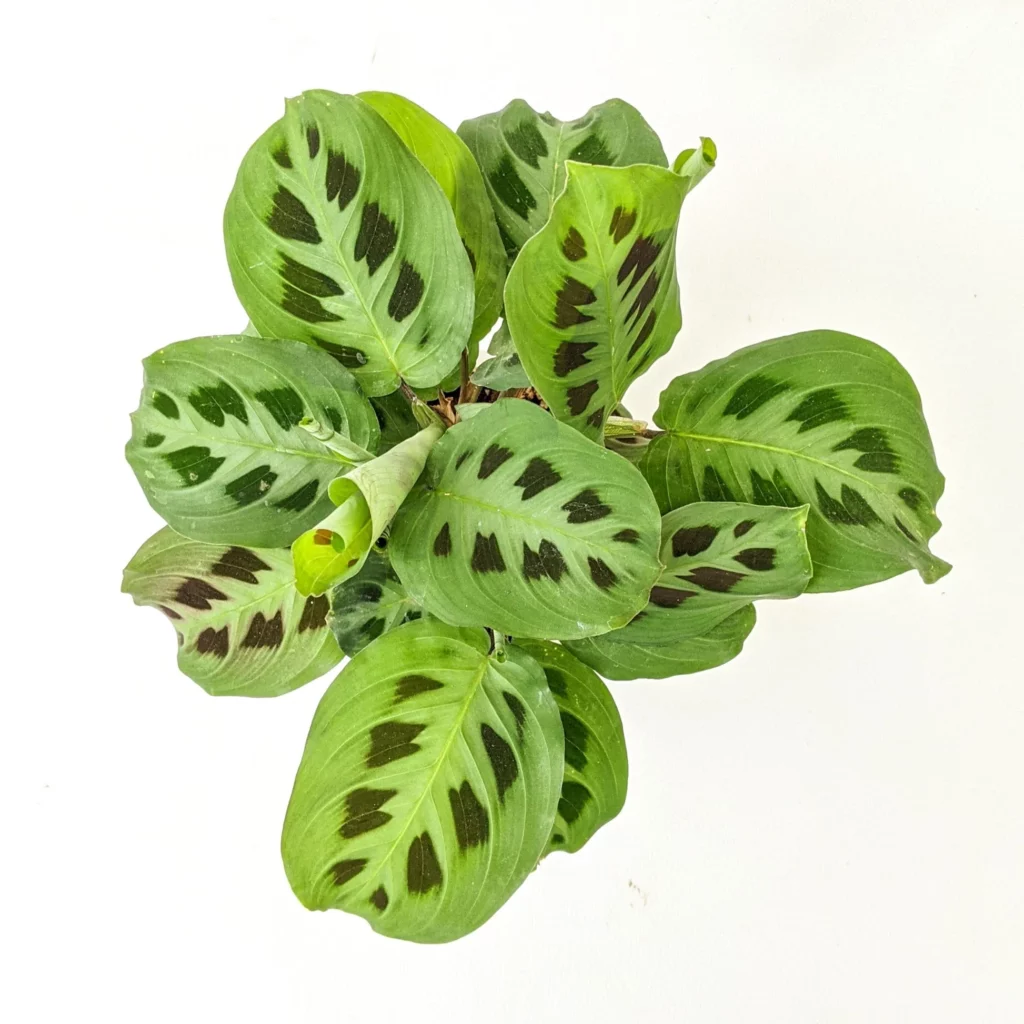
This species features oval-shaped leaves with a deep green colour and a stunning pattern of silver-green veins. It is a smaller Prayer Plant, reaching only 6 to 8 inches in height, but it makes up for its size with its striking foliage.
Maranta leuconeura “Erythroneura”

This cultivar has dark green leaves with red veins and a purple underside. It is a medium-sized plant, reaching up to 18 inches in height, and its unique colouring makes it a popular choice among indoor gardeners.
Maranta leuconeura “Massangeana”
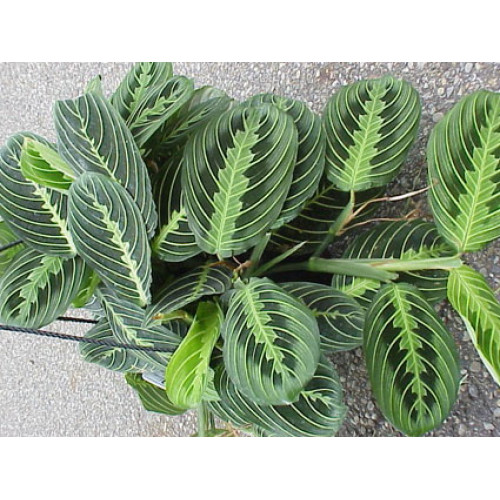
This species has large, oval-shaped leaves with a deep green colour and a stunning pattern of light green veins. It is a medium-sized plant, reaching up to 12 inches in height, and its bold foliage makes it a popular choice for statement pieces in a room.
Maranta leuconeura “Silver Feather”
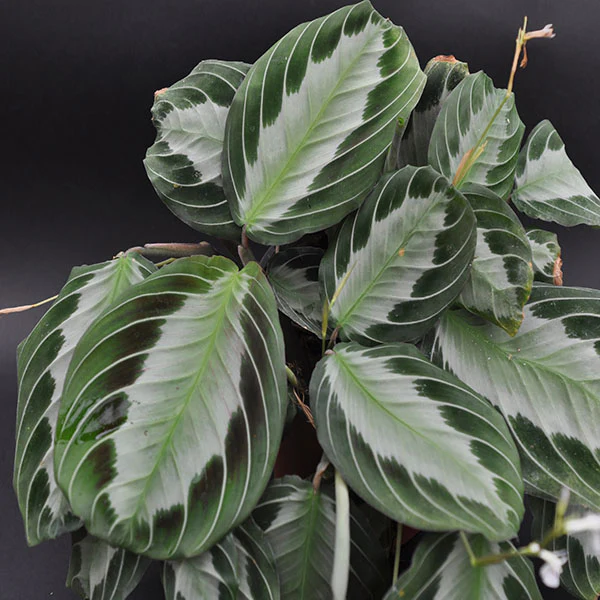
This cultivar has dark green leaves with a beautiful silver-grey feather-like pattern that is striking. The plant is small, reaching only 6 to 8 inches in height, but its unique colouring and pattern make it a standout choice.
Propagating Prayer Plants
Propagating a Prayer Plant, or Maranta leuconeura, is a relatively simple process that can help you expand your plant collection or share your love of plants with others. Two main methods for propagating a Prayer Plant are division and stem cuttings.
Division
Propagating by division involves separating the root system of an existing plant into two or more sections, each with its stem and roots. This method works best with larger, established plants that have outgrown their current pot. Here are the steps to propagate a Prayer Plant by division:
- Carefully remove the plant from its pot, not damaging the roots.
- Gently separate the root ball into two or more sections, ensuring each has at least one healthy stem and root system.
- Plant each section in its own pot, using well-draining potting soil.
- Water each new plant thoroughly and place it in a bright, indirect light.
- Stem Cuttings: Propagating by stem cuttings involves taking a cutting from a healthy plant and encouraging it to root in water or soil. This method works best with smaller, younger plants that have not outgrown their current pot. Here are the steps to propagate a Prayer Plant by stem cuttings:
- Choose a healthy stem with several leaves, and make a clean cut just below a node (where a leaf meets the stem).
- Remove the lower leaves, leaving only the top two or three.
- Dip the cut end of the stem in rooting hormone, if desired.
- Place the stem cutting in water or soil. If using water, change the water every few days to prevent bacteria growth. If using soil, ensure the soil is moist but not waterlogged.
- Place the cutting in a bright, indirect light and wait for the roots to develop. This can take several weeks.
- Once the cutting has developed roots, transplant it into its pot using well-draining potting soil.
Common Pests
Prayer Plants can be susceptible to pests that can damage or kill the plant if not addressed like all houseplants. Below are some of the most common pests that can affect Prayer Plants and how to prevent or treat them:
Spider Mites
These tiny insects are common in warm, dry environments and can be identified by the fine webbing they produce on plants. They feed on the plant sap, causing leaves to yellow and wilt. To prevent or treat spider mites, keep the plant humid, prune affected leaves, and use insecticidal soap or neem oil to kill the pests.
Mealybugs
These small, white insects cluster on the stems and undersides of leaves, feeding on the plant’s sap. They can be identified by their fuzzy appearance and the sticky remains they produce. To prevent or treat mealybugs, isolate affected plants, prune affected leaves, and use insecticidal soap or neem oil to kill the pests.
Scale Insects
These small, oval-shaped insects attach themselves to the leaves and stems of plants, feeding on the sap of the plant. Their hard, shell-like appearance can identify them. To prevent or treat scale insects, use a soft brush to remove them from the plant, use insecticidal soap or neem oil to kill the pests, and keep the plant in a humid environment.
Fungus Gnats
These small, flying insects are attracted to moist soil and can be identified by the small larvae they produce in the soil. The larvae feed on the plant’s roots, causing it to wilt and die. To prevent or treat fungus gnats, allow the soil to dry out between waterings, add a layer of sand to the top of the soil to deter egg-laying, and use insecticidal soap or neem oil to kill the pests.
Growing Tips
Here are some general growing tips for Prayer Plants to help keep them healthy and thriving:
Light
Most varieties of Prayer Plants prefer bright, indirect light. Direct sunlight can burn the leaves, while too little light can cause the plant to become leggy and lose its vibrancy. However, some varieties, such as the Calathea, prefer lower light conditions.
Water
Prayer Plants prefer consistently moist soil but avoid overwatering as this can lead to root rot. Water when the top inch of soil feels dry to the touch, and ensure the pot has proper drainage. Water quality is also important, as these plants are sensitive to chlorine and fluoride. If tap water is used, let it sit out overnight to allow the chemicals to dissipate.
Humidity
Prayer Plants prefer a humid environment, so mist the leaves regularly or place a humidifier nearby. Alternatively, place a tray of pebbles and water underneath the pot to increase humidity.
Soil
Use a well-draining, peat-based soil mix that retains moisture without becoming waterlogged. A mix that includes perlite or vermiculite can help with drainage.
Temperature
Prayer Plants prefer warm temperatures between 65-75°F (18-24°C) and should avoid drafts or cold air. Avoid temperatures below 60°F (15°C).
Fertilizer
Feed Prayer Plants with a balanced, water-soluble fertilizer every 2-3 months during the growing season. Avoid fertilizing during the winter months when the plant is dormant.
Pruning
Regular pruning can help maintain the plant’s shape and prevent legginess. Remove dead or yellowing leaves, and pinch back new growth to encourage bushiness.
Propagation
Prayer Plants can be propagated through stem cuttings or division. See the “Propagating Prayer Plants” section for more information.
Pruning and Maintenance
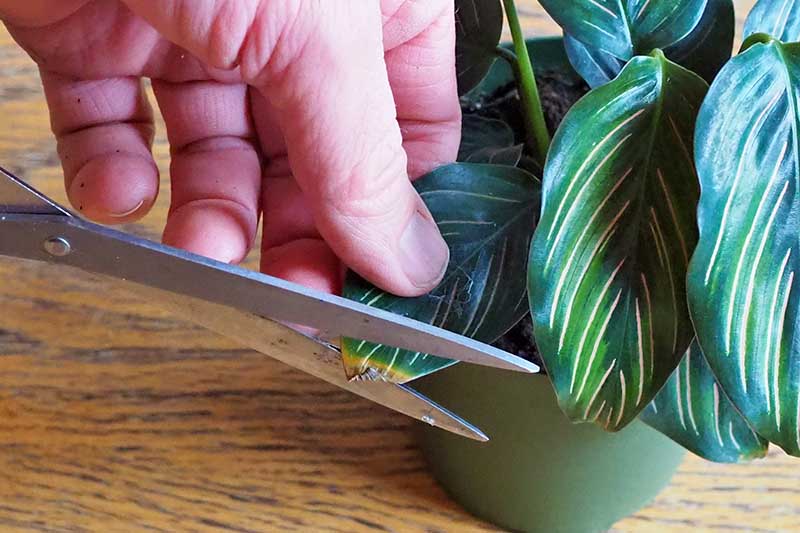
Pruning and maintenance are important aspects of keeping your Prayer Plant healthy and looking its best. Here are some tips to help you care for your plant:
Pruning
Regular pruning can help maintain the plant’s shape and prevent legginess. Remove dead or yellowing leaves, and pinch back new growth to encourage bushiness. Use sharp, clean scissors or pruning shears to avoid damaging the plant.
Cleaning
Wipe the leaves of your Prayer Plant regularly with a damp cloth to remove dust and debris. This will help improve the plant’s ability to photosynthesize and also prevent pest infestations.
Repotting
As your Prayer Plant grows, it may outgrow its current pot. Repot the plant into a slightly larger pot with fresh soil every 1-2 years or when you see roots emerging from the bottom. Be careful not to damage the roots when repotting.
Pest control
Watch for any signs of pests, such as spider mites or mealybugs. Treat any infestations promptly with an appropriate insecticide or by washing the leaves with a gentle soap and water solution.
Watering
Water your Prayer Plant consistently, but be careful not to overwater, as this can lead to root rot. Allow the top inch of soil to dry out before watering again, and ensure the pot has proper drainage.
Humidity
Prayer Plants prefer a humid environment, so mist the leaves regularly or place a humidifier nearby. Alternatively, place a tray of pebbles and water underneath the pot to increase humidity.
Where to Buy
Prayer Plants are a popular and widely available houseplant and can be purchased from various sources. Here are some options for where to buy Prayer Plants:
Local plant nurseries and garden centres
Check out your plant nurseries or garden centres to see if they carry Prayer Plants. These retailers often have a wide selection of indoor plants, and you may find a variety of Prayer Plant that is well-suited to your space.
Online plant retailers
Many online retailers specialize in selling houseplants, including Prayer Plants. These retailers often have a larger selection than local stores and can ship plants directly to your door.
Online marketplaces
Online marketplaces such as Etsy or Amazon also offer various options for purchasing Prayer Plants from individual sellers.
Home improvement stores
Home improvement stores such as Home Depot or Lowe’s often carry houseplants, including Prayer Plants, in their garden centres.
When purchasing a Prayer Plant, be sure to inspect the plant carefully for signs of pests or disease. Look for a plant with healthy leaves and a well-developed root system. You can find a beautiful Prayer Plant to add to your indoor garden with some research and patience.
Managing Pests and Diseases
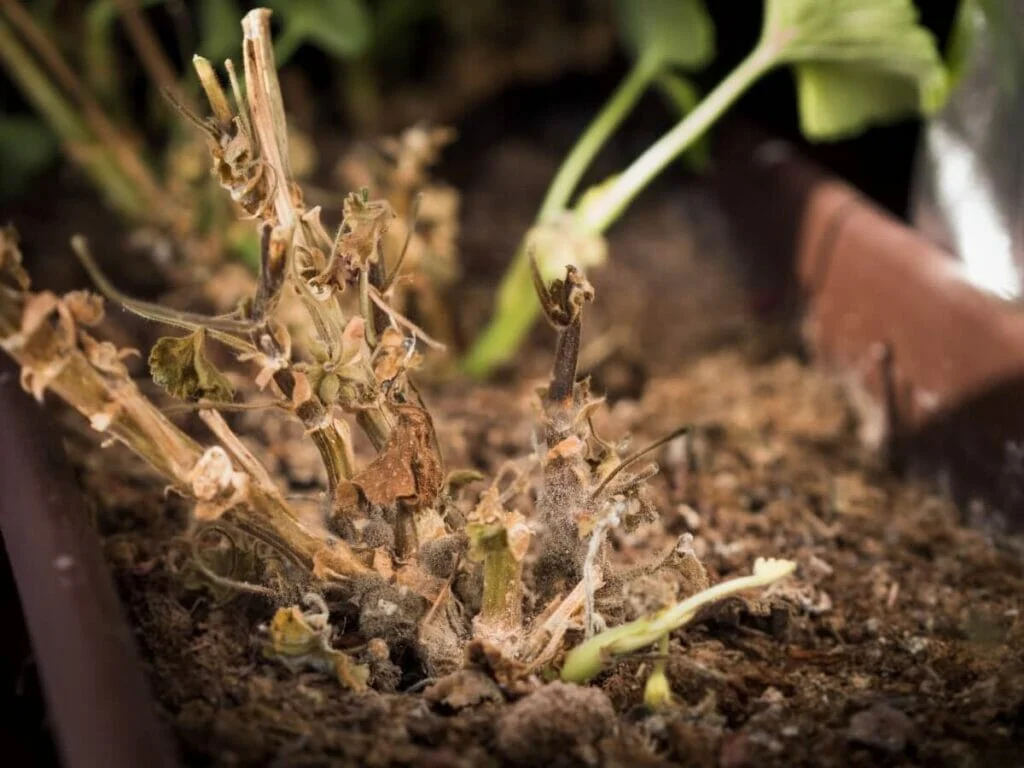
Like all plants, Prayer Plants are susceptible to pests and diseases. Here are some common pests and diseases that can affect Prayer Plants, as well as tips for managing them:
Spider mites
These tiny pests can be challenging to see, but they leave behind webbing and cause leaves to turn yellow and die. To manage spider mites, regularly wipe the leaves with a damp cloth and increase humidity around the plant. You can also use an insecticidal soap or neem oil to kill spider mites.
Mealybugs
Mealybugs are small, white insects found on the leaves and stems of Prayer Plants. They suck sap from the plant and cause yellowing and stunted growth. Wipe the leaves with a damp cloth and apply insecticidal soap or neem oil to manage mealybugs. You can also remove mealybugs with a cotton swab dipped in rubbing alcohol.
Scale insects
Scale insects are small, oval-shaped pests that attach themselves to the leaves and stems of Prayer Plants. They suck sap from the plant and cause yellowing and stunted growth. Wipe the leaves with a damp cloth and apply insecticidal soap or neem oil to manage scale insects. You can also remove scale insects with a cotton swab dipped in rubbing alcohol.
Root rot
Overwatering can cause root rot, which brown, mushy roots can identify. Remove the plant from the soil to manage root rot and trim any affected roots. Repot the plant in fresh soil and avoid overwatering in the future.
Leaf spot
Leaf spot is a fungal disease that causes brown or black spots on the leaves of Prayer Plants. To manage leaf spots, remove infected leaves and improve air circulation around the plant. You can also use a fungicidal spray to prevent the spread of the disease.
Regularly inspecting your Prayer Plant for signs of pests or disease can catch any problems early and prevent them from spreading. Your Prayer Plant can thrive and brighten your indoor space with proper care and management.
Best Uses
Prayer Plants are beautiful and versatile houseplants that can be used in various ways to enhance your indoor space. Here are some of the best uses for Prayer Plants:
Decorative accent
With their unique foliage and vibrant colours, Prayer Plants make a beautiful decorative accent for any room in your home. They can be placed on a tabletop or shelf or hung from a hook or ceiling to create a dramatic display.
Natural air purifier
Like all plants, Prayer Plants help to purify the air by removing toxins and pollutants. They effectively remove formaldehyde, benzene, and trichloroethylene from the air.
Stress relief
Prayer Plants are known for their calming effect, which makes them a great addition to your bedroom or meditation space. Their slow, rhythmic movements can help to reduce stress and promote relaxation.
Natural divider
If you have an open-concept living space or a large room that you would like to divide, Prayer Plants can be used to create a natural partition. Place several plants in a row to create a living wall that adds privacy and visual interest.
Gift: Prayer Plants make a thoughtful and beautiful gift for any occasion. Whether you’re looking for a housewarming present, a birthday gift, or a way to say thank you, a Prayer Plant will surely be appreciated.
Common Issues for Your Prayer Plant
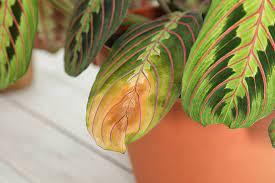
While Prayer Plants are generally easy to care for, they can sometimes develop issues that must be addressed. Here are some common problems and how to resolve them:
Yellowing leaves
If your Prayer Plant’s leaves turn yellow, it could be a sign of overwatering or underwatering. Check the soil moisture level and adjust the watering accordingly. In addition, make sure the plant is not in direct sunlight, as this can also cause leaf yellowing.
Brown tips on leaves
Brown tips on the leaves can be caused by low humidity levels or over-fertilization. Increase the humidity around the plant by misting it regularly or placing a humidifier nearby. If you suspect over-fertilization, reduce the frequency of fertilization.
Curling leaves
Curling leaves can be a sign of underwatering, overwatering, or low humidity levels. Check the soil moisture level and adjust watering as needed. Increase the humidity around the plant by misting it regularly or placing a humidifier nearby.
Pest infestations
Prayer Plants can be susceptible to spider mites, mealybugs, and scale insects. If you notice any signs of infestation, such as webbing, small white insects, or waxy bumps on the leaves, isolate the plant and treat it with an appropriate insecticide or by wiping the leaves with a cloth soaked in soapy water.
Root rot
Overwatering or poorly-draining soil can lead to root rot in Prayer Plants. If you suspect root rot, remove the plant from the soil, trim away any affected roots, and repot the plant in fresh, well-draining soil.
By being attentive to your Prayer Plant’s needs and addressing any issues promptly, you can help ensure it remains healthy and thriving.
Benefits of prayer plant
Here are some benefits of prayer plant:
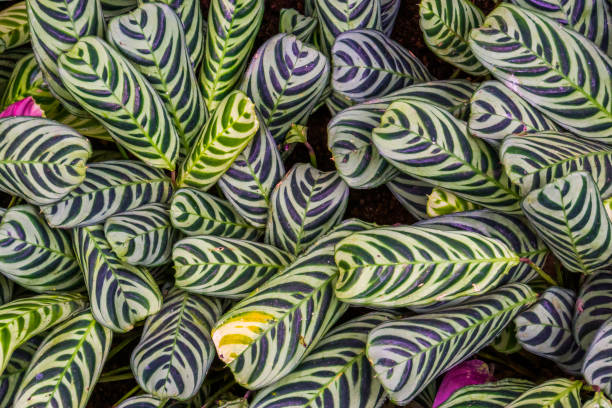
- Prayer Plants have air-purifying qualities that can help improve indoor air quality.
- They are low-maintenance plants that are easy to care for.
- They can thrive in various indoor environments, making them a versatile choice for any home or office.
- They prefer bright, indirect light and high humidity levels, which can help create a healthier indoor environment.
- The unique foliage of the Prayer Plant makes it a visually appealing addition to any space.
- Some cultures consider the Prayer Plant to be a lucky plant that can bring prosperity and abundance.
- They can help reduce stress and promote a calming atmosphere in your living space.
Conclusion
In conclusion, Prayer Plants are beautiful, unique houseplants popular for their striking foliage and low-maintenance care requirements. Their air-purifying qualities and ability to thrive in various indoor environments make them a great addition to any home or office. With the proper care and attention, they can live for several years and provide a beautiful and calming presence in your living space. Whether you are a seasoned plant enthusiast or a beginner, the Prayer Plant is a great choice to add greenery to your indoor space.
Some FAQs
Q: What is special about a prayer plant?
A: Prayer Plants are known for their unique foliage, which folds up at night like hands in prayer. They also have air-purifying qualities and are low-maintenance plants that can thrive in various indoor environments.
Q: Where is the best place to put a prayer plant?
A: Prayer Plants prefer bright, indirect light and high humidity levels, so placing them near a window with filtered sunlight or in a bathroom with a shower can provide the ideal growing conditions.
Q: Why is it called a prayer plant?
A: The name “prayer plant” comes from how the leaves fold up at night, resembling hands folded in prayer.
Q: How do you take care of a praying plant?
A: To care for a Prayer Plant, keep it in bright, indirect light, maintain high humidity levels, water it regularly but avoid overwatering, fertilize every 2-4 weeks during the growing season, and prune as needed.
Q: Do prayer plants need full sun?
A: No, Prayer Plants prefer bright, indirect light to full sun. Direct sunlight can scorch their leaves.
Q: Is the prayer plant lucky?
A: In some cultures, Prayer Plants are considered lucky and believed to bring prosperity and abundance.
Q: Which plant brings money?
A: Many plants are believed to bring money and good luck, including Jade plants, Pachira aquatica (also known as the Money Tree), and the Chinese Money Plant.
Q: Is the prayer plant suitable for the house?
A: Yes, Prayer Plants are visually appealing and have air-purifying qualities that can help improve indoor air quality.
Q: What room is best for the prayer plant?
A: A Prayer Plant can thrive in various indoor environments, but it prefers high humidity levels, making it a good choice for bathrooms, kitchens, or other rooms with high moisture levels.
Q: How long do prayer plants live?
A: A Prayer Plant can live for several years with proper care. However, they may decline after a few years and eventually need to be replaced.
Q: Why do prayer plants pray at night?
A: Prayer Plants have a circadian rhythm that causes their leaves to fold up at night, resembling hands in prayer. This is thought to help protect the plant’s sensitive leaves from drying out or becoming damaged by cooler night-time temperatures.





